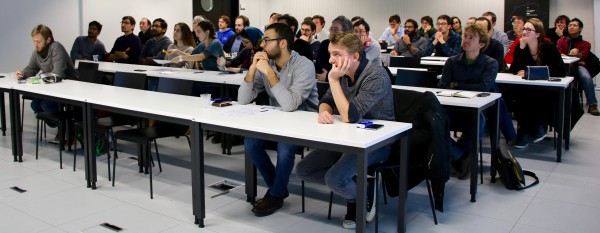MARVEL Junior Seminar — July 2020
Zoom meeting link:
https://epfl.zoom.us/j/93881551248
Password: 3417
The MARVEL Junior Seminars aim to intensify interactions between the MARVEL Junior scientists belonging to different research groups.
Each seminar consists of two presentations of 25 minutes each, allowing to present on a scientific question in depth, followed by time for discussion. The discussion is facilitated and timed by the chair.

MARVEL Junior Seminar Organizing Committee — Giuliana Materzanini, Stefano Falletta, Markus Stricker, Kristians Cernevics, Max Veit and Patrick Mayor
Talk 1 — A unified approach to enhanced sampling
Michele Invernizzi1,2 , Pablo Piaggi3 , Michele Parrinello4,2
1 Department of Physics, ETH Zurich c/o USI campus, Lugano
2 Institute of Computational Science, USI Lugano
3 Department of Chemistry, Princeton University
4 Department of Chemistry and Applied Biosciences, ETH Zurich c/o USI campus, Lugano and Italian Institute of Technology, Genova
The sampling problem lies at the heart of atomistic simulations and over the years many different enhanced sampling methods have been proposed to alleviate it. These methods are often grouped into two broad families. On the one hand methods such as umbrella sampling and metadynamics that build a bias potential based on few order parameters or collective variables. On the other hand tempering methods such as replica exchange that combine different thermodynamic ensembles in one single expanded ensemble.
We propose a new method that can be used to sample any of the ensembles typically sampled via replica exchange, but does so with a collective variables based bias potential. This method is an extension of the recently developed on-the-fly probability enhanced sampling method [1] that has been previously used for metadynamics-like sampling. It presents only few robust external parameters, making it reliable and simple to use. Furthermore it can be used with any number of parallel replicas and has a straightforward post-processing reweighting scheme. The proposed method provides an extremely general framework that can be used to achieve different types of enhanced sampling.
[1] Invernizzi and Parrinello, J. Phys. Chem. Lett. 11.7 (2020)
Talk 2 — Lithium solid state electrolytes from first-principles molecular dynamics
Giuliana Materzanini1, Leonid Kahle1, Aris Marcolongo2, Nicola Marzari1
1 Theory and Simulations of Materials (THEOS), EPFL
2 IBM RSM Zurich Research Laboratory
Replacing the conductive but flammable liquid organic electrolytes with solid state electrolytes (SSE) would significantly improve the safety of commercial Li-ion batteries, and superionic materials (solids with a liquid-like ionic sublattice) are the natural candidates for this. We employ first-principles molecular dynamics (FPMD [1]) simulations (NVT and NPT ensemble) to study the conductivity, elastic moduli and phase transitions of Li10GeP2O12 (LGPO), the oxide analogue of one of the best conducting SSE, Li10GeP2S12 (LGPS [2]). The aim is to find a material highly conductive but also with appealing electrochemical properties of an oxide [3].
By employing NVT-FPMD between 600K and 1200K, we first investigate LGPO in the same tetragonal phase as the one adopted by LGPS (here t-LGPO) and we find it highly conductive. NPT simulations at 600K of this phase and of the experimentally known and less conductive orthorhombic phase (here o-LGPO [4]) show that t-LGPO is higher in enthalpy (~45 meV/atom) than o-LGPO. We thus investigate the possibility of an entropy-driven transition at high temperatures, starting from the two phases, and find that the two structures transform at T~1100K into a third phase, highly conductive, that preserves its structure by quenching at 600K.
[1] P. Giannozzi et al., J. Phys. Condens. Matter 21, 395502 (2009).
[2] N. Kamaya et al., Nat. Mater. 10, 682 (2011).
[3] G. Materzanini et al., in preparation.
[4] E. Gilardi, G. Materzanini et al., submitted to Appl.Energy Mater. (2020).
Check the list of the next MARVEL Junior Seminars here.
Low-volume newsletters, targeted to the scientific and industrial communities.
Subscribe to our newsletter